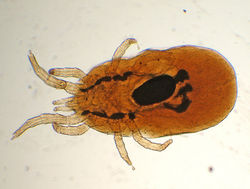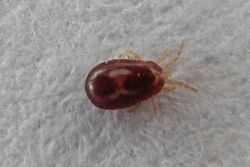Difference between revisions of "Dermanyssus gallinae"
| Line 7: | Line 7: | ||
|species =''D.gallinae'' | |species =''D.gallinae'' | ||
}} | }} | ||
| − | + | Also Known As: '''''Poultry Mite — Red Poultry Mite — Chicken Mite''''' | |
| − | Also Known As ''''' | ||
==Introduction== | ==Introduction== | ||
| Line 16: | Line 15: | ||
''D. gallinae'' are spider like mites. They are '''white or grey in colour and become red''' when engorged with blood after feeding. They have few hairs on their body and have hooks on their long legs. | ''D. gallinae'' are spider like mites. They are '''white or grey in colour and become red''' when engorged with blood after feeding. They have few hairs on their body and have hooks on their long legs. | ||
| − | ''D. gallinae'' is considered one of the most '''serious pests''' of poultry. | + | ''D. gallinae'' is considered one of the most '''serious pests''' of poultry. It may also act as a vector for diseases such as [[Salmonellosis]] and [[Borrelia anserina|avian spirochaetosis]] and others in mammalian livestock although this is still poorly understood. |
| − | It may also act as a vector for diseases such as [[Salmonellosis]] and [[Borrelia anserina|avian spirochaetosis]] and others in mammalian livestock although this is still poorly understood. | ||
''D. gallinae'' can also be '''zoonotic''', causing dermatitis and skin lesions in people. | ''D. gallinae'' can also be '''zoonotic''', causing dermatitis and skin lesions in people. | ||
==Distribution== | ==Distribution== | ||
| − | Europe, USA and most of Northern Hemisphere | + | Europe, USA and most of Northern Hemisphere. |
==Signalment== | ==Signalment== | ||
| − | The primary host is the chicken but a range of domestic and wild birds can be infected<ref> Moss, W. W (1978) '''The mite genus Dermanyssus: a survey, with description of Dermanyssus trochilinis, n. sp. and a revised key to the species (Acari: Mesostigmata: Dermanyssisdae)'''. J Med Entomology 14:627-640</ref>. The mites can also affect mammals and people<ref>Hoffman, G (1987) '''Vogelmilben als Lästlinge Krankenheitsserzeuger und Vektoren bei Mensch und Nutztier.''' Deutsche Tierärztliche Woschenschrift, 95:7-10.</ref>, usually those close to bird accommodation and infections are usually transient, presenting only when inadequate avian hosts are available. | + | The primary host is the chicken but a range of domestic and wild birds can be infected<ref> Moss, W. W (1978) '''The mite genus Dermanyssus: a survey, with description of ''Dermanyssus trochilinis'', n. sp. and a revised key to the species (Acari: Mesostigmata: Dermanyssisdae)'''. ''J Med Entomology'' 14:627-640</ref>. The mites can also affect mammals and people<ref>Hoffman, G (1987) '''Vogelmilben als Lästlinge Krankenheitsserzeuger und Vektoren bei Mensch und Nutztier.''' ''Deutsche Tierärztliche Woschenschrift'', 95:7-10.</ref>, usually those close to bird accommodation, and infections are usually transient, presenting only when inadequate avian hosts are available. |
Chicks and young birds are more susceptible. | Chicks and young birds are more susceptible. | ||
==Life Cycle== | ==Life Cycle== | ||
| − | ''D. gallinae'' progresses through '''5 life stages''': egg, larva, protonymph, deutonymph and adult<ref>Maurer, V., Baumgärtner, J (1992). '''Temperature influence on life table statistics of the chicken mite Dermanyssus gallinae (Acari: Dermanyssidae)'''. Experimental & Applied Acarology, 15(1):27-40; 19.</ref>. | + | ''D. gallinae'' progresses through '''5 life stages''': egg, larva, protonymph, deutonymph and adult<ref>Maurer, V., Baumgärtner, J (1992). '''Temperature influence on life table statistics of the chicken mite ''Dermanyssus gallinae'' (Acari: Dermanyssidae)'''. ''Experimental & Applied Acarology'', 15(1):27-40; 19.</ref>. Each stage except the larval requires a bloodmeal in order to transform to the next.<ref>Collins, D. S., Cawthorne, R. J. G (1976) '''Mites in poultry houses'''. ''Agric Northern Ireland,'' 51:24-26</ref> |
| − | |||
| − | Each stage except the larval requires a bloodmeal in order to transform to the next.<ref>Collins, D. S., Cawthorne, R. J. G (1976) '''Mites in poultry houses'''. Agric Northern Ireland, 51:24-26</ref> | ||
Development takes around '''1 week''' in total in optimal conditions. Adults spend most of their time away from the host and can survive several months without feeding. Most bloodfeeding occurs at night. | Development takes around '''1 week''' in total in optimal conditions. Adults spend most of their time away from the host and can survive several months without feeding. Most bloodfeeding occurs at night. | ||
| Line 56: | Line 52: | ||
==Control== | ==Control== | ||
Control is also via environmental and bird applied [[Ectoparasiticides|ectoparasiticides]]. | Control is also via environmental and bird applied [[Ectoparasiticides|ectoparasiticides]]. | ||
| + | |||
{{Learning | {{Learning | ||
| − | |literature search= | + | |literature search= [http://www.cabdirect.org/search.html?rowId=1&options1=AND&q1=%22Dermanyssus+gallinae%22&occuring1=title&rowId=2&options2=AND&q2=&occuring2=freetext&rowId=3&options3=AND&q3=&occuring3=freetext&x=39&y=10&publishedstart=yyyy&publishedend=yyyy&calendarInput=yyyy-mm-dd&la=any&it=any&show=all ''Dermanyssus gallinae'' publications] |
| − | |||
|flashcards = [[Mites Flashcards]] | |flashcards = [[Mites Flashcards]] | ||
}} | }} | ||
| + | |||
==References== | ==References== | ||
<references/> | <references/> | ||
Animal Health & Production Compendium, '''Dermanyssus gallinae datasheet''', accessed 21/06/2011 @ http://www.cabi.org/ahpc/ | Animal Health & Production Compendium, '''Dermanyssus gallinae datasheet''', accessed 21/06/2011 @ http://www.cabi.org/ahpc/ | ||
| − | |||
| − | |||
| − | |||
| − | |||
| − | |||
| + | {{review}} | ||
| + | [[Category:CABI Expert Review]] | ||
| + | [[Category:Dermatological Diseases - Birds]] | ||
| + | [[Category:Zoonoses]] | ||
[[Category:Non-Burrowing_Mites]] [[Category:Avian Parasites]] | [[Category:Non-Burrowing_Mites]] [[Category:Avian Parasites]] | ||
Revision as of 14:11, 28 June 2011
| Dermanyssus gallinae | |
|---|---|
| Phylum | Arthropoda |
| Order | Mesostigmata |
| Family | Dermanyssidae |
| Genus | Dermanyssus |
| Species | D.gallinae |
Also Known As: Poultry Mite — Red Poultry Mite — Chicken Mite
Introduction
Dermanyssus gallinae are red surface mites of poultry.
D. gallinae are spider like mites. They are white or grey in colour and become red when engorged with blood after feeding. They have few hairs on their body and have hooks on their long legs.
D. gallinae is considered one of the most serious pests of poultry. It may also act as a vector for diseases such as Salmonellosis and avian spirochaetosis and others in mammalian livestock although this is still poorly understood.
D. gallinae can also be zoonotic, causing dermatitis and skin lesions in people.
Distribution
Europe, USA and most of Northern Hemisphere.
Signalment
The primary host is the chicken but a range of domestic and wild birds can be infected[1]. The mites can also affect mammals and people[2], usually those close to bird accommodation, and infections are usually transient, presenting only when inadequate avian hosts are available.
Chicks and young birds are more susceptible.
Life Cycle
D. gallinae progresses through 5 life stages: egg, larva, protonymph, deutonymph and adult[3]. Each stage except the larval requires a bloodmeal in order to transform to the next.[4]
Development takes around 1 week in total in optimal conditions. Adults spend most of their time away from the host and can survive several months without feeding. Most bloodfeeding occurs at night.
Clinical Signs
Dermanyssus gallinae are blood sucking mites, causing lesions usually found on the breast and legs. Their presence can cause pain, irritation, restlessness and a decrease in egg production. Pustules, scales, scabs, hyperpigmentation and feather loss may develop locally. If secondary infection occurs, lesions may also exhibit a foul odour.
If they are present in large numbers, they can cause anaemia with consequent pallor, weakness and lethargy. Pallor may be especially pronounced in the comb and wattle.
Newly hatched chicks can rapidly die if infested.
Diagnosis
Diagnosis is usually based on history of decreasing egg production, anaemia, mortalities in young or ill birds and the finding of mites on birds (often solely at night) or in the buildings.
Reddish-black drops of mite faeces may be seen on eggs.
Mites can also be attracted to corrugated cardboard traps and thus identified.
Treatment
Treatment of mites depends upon ectoparasiticides, applied directly to hens or to the buildings between flock cycles. Many compounds are effective, but food hygiene regulations and withdrawal periods should be considered when selecting a treatment. It is advisable to alternate the compound used in order to minimise resistance, which is already emerging. It should be noted that Ivermectin does not work against D. gallinae.
Control
Control is also via environmental and bird applied ectoparasiticides.
| Dermanyssus gallinae Learning Resources | |
|---|---|
 Test your knowledge using flashcard type questions |
Mites Flashcards |
 Search for recent publications via CAB Abstract (CABI log in required) |
Dermanyssus gallinae publications |
References
- ↑ Moss, W. W (1978) The mite genus Dermanyssus: a survey, with description of Dermanyssus trochilinis, n. sp. and a revised key to the species (Acari: Mesostigmata: Dermanyssisdae). J Med Entomology 14:627-640
- ↑ Hoffman, G (1987) Vogelmilben als Lästlinge Krankenheitsserzeuger und Vektoren bei Mensch und Nutztier. Deutsche Tierärztliche Woschenschrift, 95:7-10.
- ↑ Maurer, V., Baumgärtner, J (1992). Temperature influence on life table statistics of the chicken mite Dermanyssus gallinae (Acari: Dermanyssidae). Experimental & Applied Acarology, 15(1):27-40; 19.
- ↑ Collins, D. S., Cawthorne, R. J. G (1976) Mites in poultry houses. Agric Northern Ireland, 51:24-26
Animal Health & Production Compendium, Dermanyssus gallinae datasheet, accessed 21/06/2011 @ http://www.cabi.org/ahpc/
| This article has been peer reviewed but is awaiting expert review. If you would like to help with this, please see more information about expert reviewing. |

